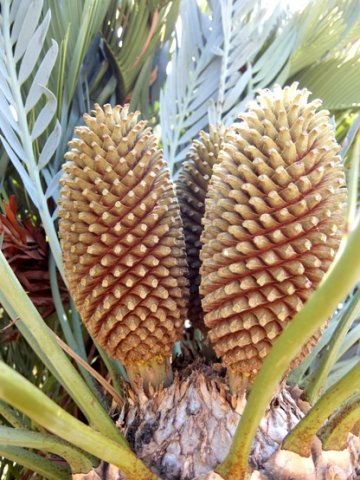Encephalartos princeps seed cones

Author: Ivan Lätti
Photographer: Thabo Maphisa
Female cones or seed cones of Encephalartos princeps grow about 15 cm wider than the (also shorter) male or pollen cones. Dimensions are up to 25 cm tall and 10 cm wide for male cones, while up to 40 cm tall and 25 cm wide for female ones.
Three cones maximum are produced in a season on one stem top in this species. The cones of both sexes are dull olive green. This one is thought to be female. It will have two naked ovules upon each of the scales topped by the visible shields seen spaced along the cone surface in spiralling rows.
On the male cone similar shields top the scales, but pollen is produced in densely packed sacs on the under-surface of each scale. The seeds produced in the female cones are 4,5 cm by 2 cm and red in colour.
The cones of both genders produce strong odours at dawn and dusk that attract weevils. Then the universal pollination drill: the weevil searches for food by following the same motivational scent once revered by its forebears. Along the way, upon its binge in the cones, some pollen gets deposited on the weevil's body, as it happens to the miller’s assistant turning white every day in the flour mill.
Task completion involves losing this “dirt” (and gradually the carrier’s hunger), among the random stops on more cones during the rest of the feeding journey. Some of this unnoticed pollen burden, never all as enough is produced to cover waste, reaches the destination crafted by evolution, namely the ovules in the female cone.
And so live many plants and their pollinators from the times that gender had come about in nature (Hugo, 2014; Coates Palgrave, 2002; iNaturalist; www.plantzafrica.com).

